

Mobile Applications are taking the world by storm. This decade has been the decade of mobile apps and the COVID-19 pandemic has accentuated this need.
More businesses are looking to become digital and are ready to enter the digital era. Do you belong to that group?
With over 200 billion mobile apps and growing, some mobile apps have reached the heights of success while some others are struggling.
Ever wondered why?
Why do some applications in the same stream fare better than their counterparts?
Well, in this article we try to uncover the secrets of the trade and show you why certain applications are rocking the app world while most others are not.
Below is our merged list of the Top 3 Mobile App Success Stories in India
With the latest mobile applications being the talk of the town, conversion of an idea into a functional mobile application is not as easy as it sounds. It’s not as simple as, poof I have an idea and here is a mobile app. Developing a rigorous mobile app requires a lot of dedication, work and undying determination to make it huge. In the booming mobile app market, it is always important to create a mobile app that is enjoyed and appreciated by your users.

Below is a list of the Top 3 successful mobile apps in India and why they are so successful
1. Flipkart

Simply put, Flipkart.com is India’s Amazon.com. It started selling books online in 2007 but was eventually expanded to include electronics and digital music. Created initially by its two partners, Flipkart received more than $180 million in funding from VC firms. It is estimated that their income back in 2012 was $100 million (source: Wikipedia). It’s probably the most successful online retailer in India with the largest market share in its sector selling 20 items per minute.
Reasons for Flipkart’s success
Product category selection
Flipkart began with books first – a product segment with high margins, low cost and easy-to-transport products. Books are often non-perishable products, and their worth does not go down over time. Flipkart did not have to maintain an inventory in the early days when orders were low, as books could be obtained directly from distributors based on number or quantity.
This preference of product category allowed Flipkart to ensure greater consumer loyalty in their formative years.
The category groups that Flipkart (electronic products and digital music) chose to enter into after their success with books also offered them similar advantages.
Convenience
Customers had the convenience of buying books without stepping outside their homes or offices. Given that most of their early customers were corporate workers living and employed in major metropolitan areas, the comfort provided by Flipkart freed the customer’s recreational time on weekends.
Consumers avoided traffic and commuting, and the catalogues offered by Flip kart were much more extensive than any retailer could offer to consumers in smaller towns and remote areas.
The efficiency of the supply chain
Flipkart ‘s greatest differentiator and pivotal moment in the market was their efficiency of the supply chain. Even though they weren’t the first e-commerce player in India, Flipkart learned to overcome the biggest problem anyone ordering online in India faced – reliable delivery of goods. By typing up national courier companies in the early days, they could secure their first stage of marketing via word of mouth. Customers used to ecstatically share stories of efficacious delivery and these further boosted sales.
Importance of customer service
While other e-commerce companies in India invested aggressively on high-decibel marketing, Flipkart poured the resources into customer service. In a world where electronic payment is weak , with 25-30% failure rates, Flipkart ‘s method of calling up consumers whose purchases did not go through was a stroke of genius. Not only did this increase their sales, but it also provided consumers with a personal feeling that the company was concerned about them.
Free shipping and discounts
As Flipkart started as an online book retailer, one of their greatest attractions was the discounts they gave for each book. Books are a high-margin commodity segment and all booker sellers including local one’s bookseller can afford to offer discounts to buyers. However, this often requires customers to request for a discount, which is not always a pleasurable experience. Flipkart did what customers wanted and offered free shipping and discounts on all their products and this was an advantage for both customers and the e-commerce platform.
Though Flipkart has now moved to electronics and other digital products, it continues to employ these techniques that made them so successful in India.
2. Swiggy

At a period when several food-tech start-ups are closing down, Swiggy the Bengaluru-based start-up, one of India’s leading food ordering and distribution platforms, has raised $35 million via a ‘Series C’ round of investment from new and established investors.
The online food ordering platform, which had earlier raised $18.5 million from Norwest Venture Partners, SAIF Partners and Accel Partners, is motivated by the concept of supplying consumers with a comprehensive food ordering and delivery solution, and the company is completely committed to their cause.
Available in 8 cities across the country, Swiggy operates in over 100 neighbourhoods with over 3000 delivery executives.
Reasons why Swiggy is loved by investors
Hardworking and driven
It is impressive that the order figure on Swiggy has grown more than 20 times over the last few months. Since its inception, the online food distribution platform has seen a steady increase in orders. And, this has helped them expand to their services to other cities.
Work on a time frame
As occurs in several cases, the delivery time posited is not the actual delivery time when someone orders food. Given the increase in orders, Swiggy kept an overall turnaround time of 36 minutes per order. Therefore, offering consumers a justification to buy food from them, allowing investors to feel that they are holding onto their commitment and promise.
Independent window for ordering
Swiggy operates its own private fleet of distribution staff from a wide variety of restaurants to pick up and send orders to its customers. Having their own delivery fleet enables them to offer their customers a variety of convenient features, such as faster delivery, no minimum order and live delivery tracking.
3. Ola

Ola Cabs is a- by-product of the suffering frequently felt by travellers in India. One of the company’s co-founders, Bhavish Aggarwal, was left stuck in the middle of his trip by the driver while he was travelling to Bandipur from Bangalore. The explanation is that he could not renegotiate the fare already negotiated by the driver. This negative experience later transformed his life and Ola was born.
Today though there are other taxi-hailing services Ola is still a pioneer in the Indian cab market.
Below are the reasons why
Wide operations
Ola functions in 110 cities and claims to have almost a million cars on its website. Which include Ola Cabs (the bread and butter), Auto Rickshaws, Shuttle Busses, Bicycle Taxis and eRickshaws.
Adopting entertainment technologies
New technologies like Ola Play and free Wi-Fi in auto-rickshaws are placing Ola a step ahead of its competitors. Ola played a masterstroke by joining up with ALTBalaji, the Balaji Telefilms digital platform, taking Hindi TV series to the back seat of their cabs. The lengthy ride has now become much more bearable.
Offering free wifi in auto-rickshaws is another game-changer in a segment where none of the major players were able to retain customers or feel the pulse of the auto driver. Ola already provides its Prime and Select customers with free WiFi.
Ola Money is a convenient payment method
Ola Money is really easy to use. If there is cash in the wallet, it will be debited first and adjusted to the fare. The passenger will pay the leftover amount by cash or by filling in the wallet after booking just before the taxi arrives. Drivers also accept other payment forms, such as PayTM, directly to their bank accounts.
Stable Management
Ola had a rather low senior management churn, and the two co-founders remain together. Added to that, Bhavich is an incredibly hard-working man who works based on the first principles. As an entrepreneur behind the venture, he is willing to take risks to ensure the success of his business and the growth of his brand.
For these reasons and more, Ola continues to be a major player in the Indian cab service market.
Take Away:
This article covered 3 important Indian start-up ventures and the reasons for their success. If you wish to launch a successful business, you can learn from the pioneers and imbibe strategies that have worked for them,
We at SpiderIndia are among visionaries in providing the Mobile App development services in India with expertise and unparalleled skill-sets in technological resources. Contact us today to discover how we can help you develop the best Mobile Application solutions for your needs.
Our services span over major cities in India, such as Chennai, Bangalore and we have international markets in Malaysia and Australia. Contact us today and get the best deal!
This is the perfect time to get in touch. You can contact us at marketing@spiderindia.com or call us at +91-44-42305023, 5337. Stop thinking, start calling.
